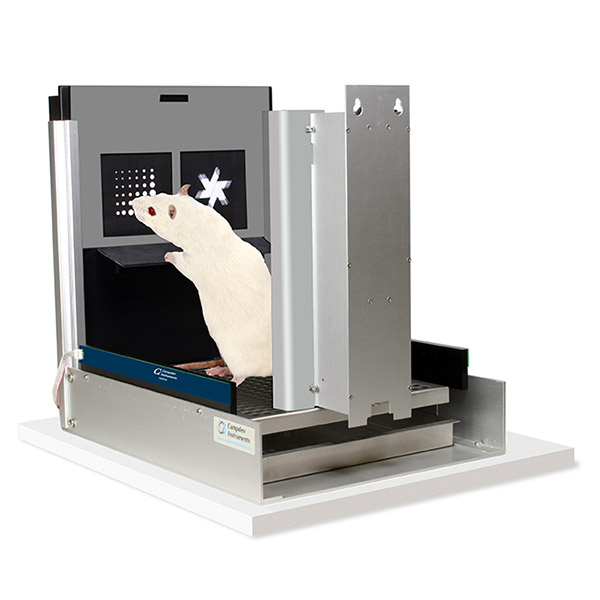
The task involves learning that one of two shapes displayed simultaneously on the screen is correct. Touching the correct stimuli (S+) will be rewarded with food. Touching the incorrect stimuli (S-) will be punished with a timeout. Once the task has been learned, the stimuli are reversed so that the S+ stimuli now becomes the S- stimuli and vice versa. This reversal learning requires inhibition of prepotent responses and is known to be dependent on the prefrontal cortex.
Tethered Rat performing the Pairwise/Visual Discrimination Task (PD), in a Bussey Touch screen chamber for Electrophysiology recording.
Grey Mouse Lemur performing the Pairwise/Visual Discrimination Task (PD) An entrance hole has been made in the side wall to allow the Grey Mouse Lemur to be placed in the chamber without handling.
Tree Shrew performing the training phase for the Pairwise/Visual Discrimination Task (PD). Another example of the multi species use of these chambers.
Liao, J., Dong, G., Wulaer, B., Sawahata, M., Mizoguchi, H., Mori, D., Ozaki, N., Nabeshima, T., Nagai, T., & Yamada, K. (2022). Mice with exonic RELN deletion identified from a patient with schizophrenia have impaired visual discrimination learning and reversal learning in touchscreen operant tasks. Behavioural Brain Research, 416, 113569. - Abstract
Dickson, P. E., & Mittleman, G. (2022). Working memory and pattern separation in founder strains of the BXD recombinant inbred mouse panel. Scientific Reports 2022 12:1, 12(1), 1–9. - Abstract
Savolainen, K., Ihalainen, J., Hämäläinen, E., Tanila, H., & Forsberg, M. M. (2021). Phencyclidine-induced cognitive impairments in repeated touchscreen visual reversal learning tests in rats. Behavioural Brain Research, 404. - Abstract
Palmer, D., Dumont, J. R., Dexter, T. D., Prado, M. A. M., Finger, E., Bussey, T. J., & Saksida, L. M. (2021). Touchscreen cognitive testing: Cross-species translation and co-clinical trials in neurodegenerative and neuropsychiatric disease. In Neurobiology of Learning and Memory (Vol. 182, p. 107443). - Abstract
Wittkowski, J., Fritz, R. G., Meier, M., & Schmidtke, D. (2021). Conditioning learning in an attentional task relates to age and ventricular expansion in a nonhuman primate (Microcebus murinus). Behavioural Brain Research, 399, 113053. - Abstract
Alvarez, B. D., Morales, C. A., & Amodeo, D. A. (2021). Impact of specific serotonin receptor modulation on behavioral flexibility. Pharmacology Biochemistry and Behavior, 209, 173243. - Abstract
Chasse, R., Malyshev, A., Fitch, R. H., & Volgushev, M. (2021). Altered heterosynaptic plasticity impairs visual discrimination learning in adenosine A1 receptor knock-out mice. Journal of Neuroscience, 41(21), 4631–4640. - Abstract
Shepherd, A., Zhang, T., Hoffmann, L. B., Zeleznikow-johnston, A. M., Churilov, L., Hannan, A. J., & Burrows, E. L. (2021). A Preclinical Model of Computerized Cognitive Training : Touchscreen Cognitive Testing Enhances Cognition and Hippocampal Cellular Plasticity in Wildtype and Alzheimer’s Disease Mice. Frontiers in Behavioral Neuroscience, 15(December), 1–15. - Abstract
Luo, J., Tan, J., & Nithianantharajah, J. (2020). Associative Learning and Motivation Differentially Requires Neuroligin-1 at Excitatory Synapses. BioRxiv, 2020.01.01.890798. - Abstract
DeBrosse, A. C., Wheeler, A. M., Barrow, J. C., & Carr, G. V. (2020). Inhibition of Catechol-O-methyltransferase Does Not Alter Effort-Related Choice Behavior in a Fixed Ratio/Concurrent Chow Task in Male Mice. Frontiers in Behavioral Neuroscience, 14. - Abstract
Mosser, C.-A., Haqqee, Z., Nieto-Posadas, A., Murai, K., Stefano, S., Williams, S., & Brandon, M. P. (2020). The McGill-Mouse-Marmoset Platform: A Standardized Approach for High-throughput Imaging of Neuronal Dynamics During Behavior. BioRxiv. - Abstract
Fritz, R. G., Zimmermann, E., Meier, M., Mestre‐Francés, N., Radespiel, U., & Schmidtke, D. (2020). Neurobiological substrates of animal personality and cognition in a nonhuman primate ( Microcebus murinus ). Brain and Behavior, 10(9). - Abstract
Jager, A., Dam, S. A., Van Der Mierden, S., Oomen, C. A., Arias-Vasquez, A., Buitelaar, J. K., Kozicz, T., & Glennon, J. C. (2020). Modulation of cognitive flexibility by reward and punishment in BALB/cJ and BALB/cByJ mice. Behavioural Brain Research, 378, 112294. - Abstract
Lindström, S. H., Sundberg, S. C., Larsson, M., Andersson, F. K., Broman, J., & Granseth, B. (2019). VGluT1 Deficiency Impairs Visual Attention and Reduces the Dynamic Range of Short-Term Plasticity at Corticothalamic Synapses. Cerebral Cortex. - Abstract
Piantadosi, P. T., Lieberman, A. G., Pickens, C. L., Bergstrom, H. C., & Holmes, A. (2019). A novel multichoice touchscreen paradigm for assessing cognitive flexibility in mice. Learning and Memory, 26(1), 24–30. - Abstract
Mantanona, C. P., Alsiö, J., Elson, J. L., Fisher, B. M., Dalley, J. W., Bussey, T., & Pienaar, I. S. (2019). Altered motor, anxiety-related and attentional task performance at baseline associate with multiple gene copies of the vesicular acetylcholine transporter and related protein overexpression in ChAT::Cre+ rats. Brain Structure and Function. - Abstract
Tamming, R., Dumeaux, V., Langlois, L., Ellegood, J., Qiu, L., Jiang, Y., Lerch, J. P., & Bérubé, N. G. (2019). Atrx Deletion in Neurons Leads to Sexually-Dimorphic Dysregulation of miR-137 and Spatial Learning and Memory Deficits. SSRN Electronic Journal. - Abstract
Rendall, A. R., Perrino, P. A., LoTurco, J. J., & Fitch, R. H. (2019). Evaluation of visual motion perception ability in mice with knockout of the dyslexia candidate susceptibility gene Dcdc2. Genes, Brain and Behavior, 18(5). - Abstract
Radke, A. K., Zweifel, L. S., & Holmes, A. (2019). NMDA receptor deletion on dopamine neurons disrupts visual discrimination and reversal learning. Neuroscience Letters, 699, 109–114. - Abstract
Phillips, B. U., Dewan, S., Nilsson, S. R. O., Robbins, T. W., Heath, C. J., Saksida, L. M., Bussey, T. J., & Alsiö, J. (2018). Selective effects of 5-HT2C receptor modulation on performance of a novel valence-probe visual discrimination task and probabilistic reversal learning in mice. Psychopharmacology, 235(7), 2101–2111. - Abstract
The Second Generation Bussey Chambers with Intelli-interface supports up to 20 chambers on one PC. On the strength of 10 years of feedback and development, the system is even more flexible and with more features.
Adapted for mice, this reversal learning task requires inhibition of prepotent responses and is known to be dependent on the prefrontal cortex.

